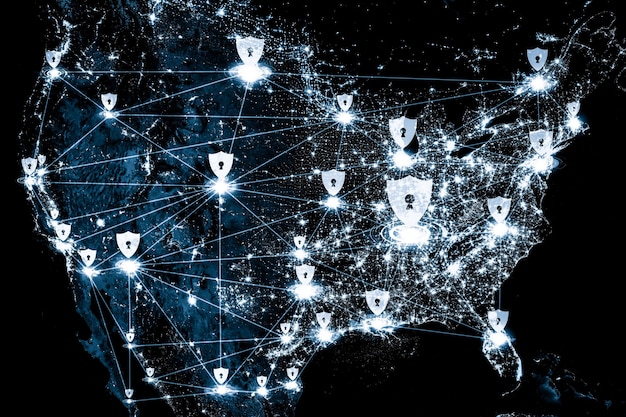Cybersecurity in the US: Navigating the Evolving Threat Landscape

The changing landscape of cybersecurity in the US reflects escalating digital threats, requiring continuous adaptation in strategies and technologies to protect sensitive data across interconnected networks.
The digital age has brought unprecedented connectivity, but it has also ushered in an era of sophisticated cyber threats. Understanding the changing landscape of cybersecurity: protecting data in a connected US is crucial for individuals, businesses, and government entities alike.
Understanding the New Cybersecurity Challenges
The digital realm faces a constant influx of new and evolving cyber threats. As technology advances, so too do the methods and techniques used by cybercriminals. This section delves into the core challenges that define the current cybersecurity environment.
Ransomware Attacks on Critical Infrastructure
Ransomware attacks have become increasingly sophisticated and are targeting critical infrastructure, such as hospitals and energy grids. These attacks not only disrupt essential services but also demand significant ransoms, making them a lucrative criminal enterprise.
Phishing and Social Engineering
Phishing attacks continue to be a primary vector for cybercrime, often using social engineering techniques to trick individuals into divulging sensitive information. These attacks are becoming more personalized and difficult to detect.
- Increased sophistication: Attackers are using more advanced methods to bypass security measures.
- Targeted campaigns: Phishing attacks are now highly tailored to specific individuals or organizations.
- Mobile vulnerabilities: Mobile devices are increasingly targeted due to their widespread use and often weaker security.
The relentless evolution of cyber threats demands a dynamic and proactive approach to cybersecurity. By understanding these challenges, organizations and individuals can better prepare and defend against potential attacks.
The Role of AI in Cybersecurity
Artificial intelligence (AI) is revolutionizing many aspects of technology, and cybersecurity is no exception. AI offers both opportunities and challenges, transforming how we defend against cyber threats and how attackers might exploit new vulnerabilities.
AI-Powered Threat Detection
AI algorithms can analyze vast amounts of data in real-time to identify anomalies and potential threats that traditional security systems might miss. This capability allows for faster and more accurate threat detection.
Automated Incident Response
AI can automate incident response processes, enabling quicker containment and mitigation of cyber attacks. This automation reduces the workload on human analysts and minimizes the impact of breaches.

AI holds immense potential to enhance cybersecurity, but it also introduces new risks. A balanced approach is necessary to harness its benefits while mitigating potential drawbacks.
Evolving Regulatory and Compliance Landscape
As cyber threats escalate, regulatory bodies are creating more stringent cybersecurity standards. Adhering to these standards is not just a legal requirement but also a crucial step in protecting sensitive data and maintaining customer trust.
Compliance with GDPR and CCPA
The General Data Protection Regulation (GDPR) and the California Consumer Privacy Act (CCPA) have set high standards for data privacy and security. Organizations must comply with these regulations to avoid hefty fines and reputational damage.
Industry-Specific Regulations
Certain industries, such as healthcare and finance, are subject to specific cybersecurity regulations like HIPAA and PCI DSS. Compliance with these standards requires specialized security measures and ongoing audits.
Companies must stay informed about the changing regulatory landscape and proactively implement measures to ensure compliance. This proactive approach not only protects against legal repercussions but also strengthens overall cybersecurity posture.
The Significance of Cybersecurity Awareness Training
Employees are often the weakest link in an organization’s cybersecurity defenses. Comprehensive cybersecurity awareness training is essential to educate employees about potential threats and how to respond appropriately.
Recognizing Phishing Attempts
Training programs should focus on teaching employees how to recognize phishing emails, suspicious links, and other social engineering tactics. This awareness can significantly reduce the risk of successful attacks.
Best Practices for Data Protection
Employees should be educated on best practices for protecting sensitive data, including password management, secure data storage, and proper use of company devices and networks.

Investing in cybersecurity awareness training is a cost-effective way to enhance an organization’s overall security posture. Well-trained employees are better equipped to identify and respond to potential threats, reducing the likelihood of successful cyber attacks.
Cloud Security: Protecting Data in the Cloud
Cloud computing has become integral to modern business, but it also introduces unique security challenges. Understanding and implementing robust cloud security measures are crucial for protecting data in the cloud.
Shared Responsibility Model
Cloud security operates on a shared responsibility model, where the cloud provider is responsible for securing the infrastructure, while the customer is responsible for securing the data and applications stored in the cloud.
Implementing Strong Access Controls
Effective access controls are essential for limiting access to sensitive data stored in the cloud. Multi-factor authentication, role-based access control, and regular access reviews can help prevent unauthorized access.
- Data encryption: Encrypting data at rest and in transit adds an extra layer of protection.
- Regular backups: Maintaining regular backups ensures data can be recovered in the event of a breach.
- Compliance certifications: Choose cloud providers with relevant security certifications to ensure they meet industry standards.
Cloud security requires a holistic approach that encompasses both technical and organizational measures. By understanding the shared responsibility model and implementing appropriate security controls, organizations can confidently leverage the benefits of cloud computing while protecting their sensitive data.
Preparing for the Future: Emerging Cyber Threats
The cybersecurity landscape is constantly evolving, with new threats emerging regularly. Staying ahead of these threats requires ongoing vigilance, research, and adaptation.
Quantum Computing and Cryptography
The advent of quantum computing poses a significant threat to current encryption methods. Quantum-resistant cryptography is being developed to address this emerging risk.
Internet of Things (IoT) Security
The proliferation of IoT devices has expanded the attack surface, creating new vulnerabilities for cybercriminals to exploit. Securing IoT devices requires robust authentication, encryption, and regular security updates.
Cybersecurity is an ongoing battle, and preparing for future threats requires a proactive and adaptive mindset. By staying informed and embracing innovative security solutions, organizations can effectively protect their data in an increasingly connected world.
| Key Point | Brief Description |
|---|---|
| 🛡️ Evolving Threats | Cyber threats are becoming more sophisticated and targeted. |
| 🤖 The Role of AI | AI enhances threat detection but also introduces new risks. |
| 👩🏫 Awareness Training | Employee training is crucial for preventing cyber attacks. |
| ☁️ Cloud Security | Securing data in the cloud requires a shared responsibility model. |
Frequently Asked Questions
Common threats include ransomware, phishing, malware, and DDoS attacks targeting both individuals and organizations across various sectors.
AI enhances threat detection by analyzing large datasets for anomalies, automating incident response, and predicting potential cyber attacks before they occur.
Training equips employees to recognize and avoid phishing attempts, use secure passwords, and follow data protection best practices, reducing human error risks.
Key regulations include GDPR, CCPA, HIPAA for healthcare, and PCI DSS for payment card industry, ensuring data privacy and security standards are met.
Businesses can implement strong access controls, encrypt data, maintain regular backups, and ensure cloud providers have appropriate security certifications for compliance.
Conclusion
In conclusion, the changing landscape of cybersecurity necessitates a proactive and adaptive approach. By staying informed about emerging threats, leveraging advanced technologies like AI, and prioritizing employee training, organizations can effectively protect their data and navigate the complexities of the digital age.





